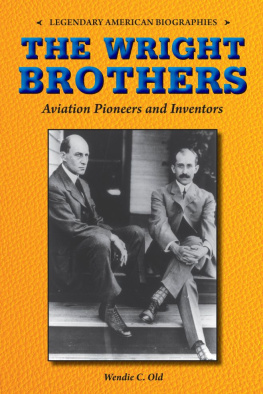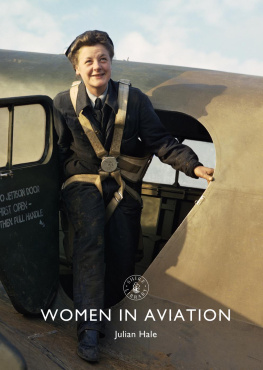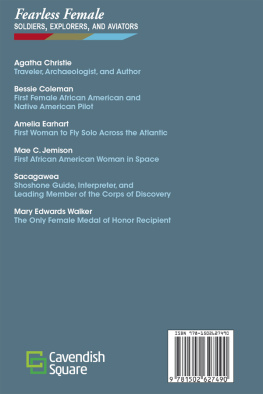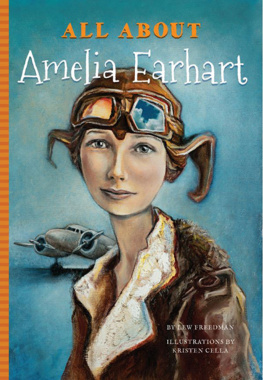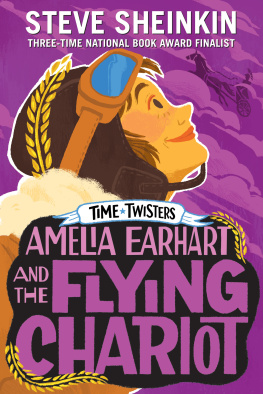

Published by The History Press
Charleston, SC 29403
www.historypress.net
Copyright 2015 by Jennifer Bean Bower
All rights reserved
First published 2015
e-book edition 2015
ISBN 978.1.62584.686.0
Library of Congress Control Number: 2014957214
print edition ISBN 978.1.60949.695.1
Notice: The information in this book is true and complete to the best of our knowledge. It is offered without guarantee on the part of the author or The History Press. The author and The History Press disclaim all liability in connection with the use of this book.
All rights reserved. No part of this book may be reproduced or transmitted in any form whatsoever without prior written permission from the publisher except in the case of brief quotations embodied in critical articles and reviews.
In memory of Viola Estelle Gentry and in honor of Helen and Richard Rich Codling.
HER ACTIVITIES IN THE PROMOTION AND DEVELOPMENT OF AVIATION HAVE ENCOURAGED WOMEN THROUGHOUT THE WORLD TO PARTICIPATE IN THE FIELD OF AERONAUTICS.
Tiny Broadwick Award plaque presented to Viola Gentry by the OX5 Club of America in 1965
Contents
Foreword
The International Womens Air & Space Museum (IWASM) was founded forty-five years ago by female pilots who knew that if something wasnt done, the history, voices and memories of the women from the early days of aviation would be lost. A collections managers time is spent logging items and storing them in archival boxes on numbered shelves where they can be found in the future. Everything is interesting, but there are so many items that the collections manager doesnt get to linger over anything for too long. It is up to researchers to find the museum and bring the artifacts back to life.
Viola Gentry came into my field of view when a woman came to IWASM to do research on an airplane Viola had flown. The box of Violas papers was brought out, and while the researcher went through them, she told me a bit about Viola Gentry. My concern at the time was the disorder the box was in and how the contents could be better organized. Violas papers also contained many photos of other female pilots.
After the researcher left, work resumed on putting the papers and photos in better folders, labeling them and splitting the contents into two boxes. There was an extra copy of Viola Gentrys book Hangar Flying in the box, and the number was recorded in the database. Copies were made of the photos, and they were cross-referenced to other files of female pilots. Who was this Viola Gentry who seemed to have been in aviation for a great span of time? I made a note to read her book someday.
The book was not an autobiography as you would expect. When the weather is bad, pilots sit around in hangars, waiting for the sky to clear and telling tales of their flying experiences. This is known as hangar flying. Viola Gentrys book is made up of these tales, and her own story is interspersed among tales of both the great and not so well-known pilots of the early days of flying. But what stories! After I finished the book, I opened the Viola Gentry boxes again to see if there was evidence that this woman had really done the things she said. The document evidence was there, as well as a little wallet of black silk that she had made to hold her various licenses and medical cards.
I began to notice more photos of Viola in the museum collections and came to know her handwriting on the back of them. She had been an early contributor to the museum archive. Anytime a photo of a group of women involved in the early days of aviation was brought out, I would peruse it and soon announce, There she is, and whoever was looking with me would know that I was once again playing Wheres Viola, or Spot the Viola.
Hangar Flying had come out in two forms, both privately published. IWASM has both the paperback and spiral bound versions. I eventually found a letter from Viola Gentry saying that IWASM could publish a better version with the photos she had gathered. That project has yet to be realized.
It was another copy of the book Hangar Flying that introduced me to Jennifer Bean Bower. She had found a copy and e-mailed IWASM requesting more information. Not having time to do anything myself with Hangar Flying, I was happy to help Jennifer with her project. A researcher has time (not more time, no one has more time) to devote to the travel and research needed to flesh out the story of their subject. The IWASM files indicated that Viola Gentry had a niece. Jennifer found the niece and others who could tell her about Viola. Thanks to Jennifer Bean Bower, the museum is now the repository of Violas memorabilia.
Charles Plank, in his 1942 book Women with Wings, referred to Viola Gentry as the selfless soul of aviation. The early days of aviation were full of colorful characters, and many of them had egos as big as the sky in which they flew. Viola Gentry was friends with all the aviation greats of her time, and she helped many attain fame. Now you will get to know this remarkable woman.
CRIS TAKACS
Collections Manager
International Womens Air & Space Museum, Cleveland, Ohio
Preface
As a native North Carolinian, I take pleasure in researching my states history, heritage and culture. In particular, I seek out people, places and events that compose the lesser-known chapters of the states history. While researching the origins of Maynard FieldNorth Carolinas first commercial airfieldin an effort to erect a historic marker near its site (the marker was unveiled in May 2008), I was introduced to Viola Estelle Gentry.
The State Archives of North Carolina and Dr. Thomas C. Parramorewho wrote the book First to Fly: North Carolina and the Beginnings of Aviationdocumented Gentry as a pioneering female pilot from North Carolina. Because I was not familiar with her, I immediately wanted to learn more; but apart from a few articles and brief mentions in aviation history books, there was not much information available. For that reason, I mined historical documents to further my knowledge, and it wasnt long before the bits and pieces of Gentrys life began to take form.
From the moment Gentry decided to fly, she set a course for the sky and did not let anythingbe it discrimination, financial hardship, misguided landings, crashes, physical limitations or tragedyput an end to her dreams. Gentrys flight attempts and endeavors offer readers another chapter in the history of early aviation, one that reveals the struggles and achievements of a working-class woman with an unyielding will to fly. Her story is one of determination and inspiration; it is a narrative that deserves a place on the bookshelf of womens aviation history.
As Gentrys story is best told through her words, and those of her contemporaries, I attempted to write in a manner that would keep my voice distant. Through the use of extracted facts and quotes from primary source materialsparticularly historical newspapers and Gentrys self-published book Hangar FlyingI feel this goal was achieved. North Carolina Aviatrix Viola Gentry: The Flying Cashier is not intended to reveal a complete history of women in aviation or aviation in general. It is simply meant to remember and honor the life of Viola Estelle Gentry, a native North Carolinian, a woman who provedthrough her aviation ventures and accomplishmentsthat dreams do come true. In researching Gentrys life, I was encouraged to follow my own dreams. My hope is that you, the reader, will be inspired by her story as much as I have been and that your every dream takes flight.
Next page


